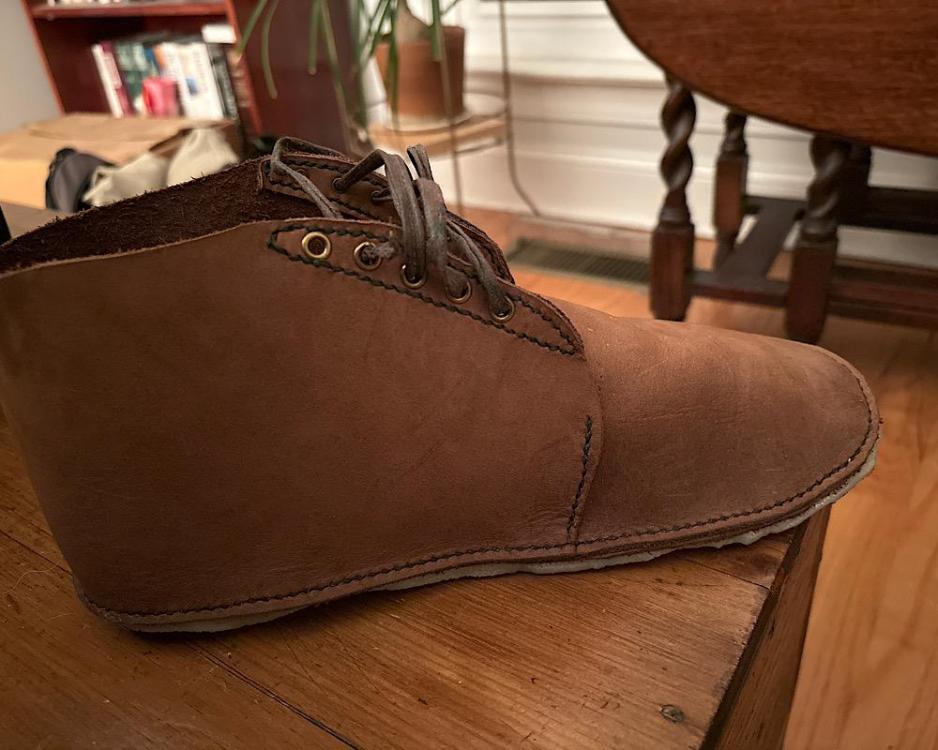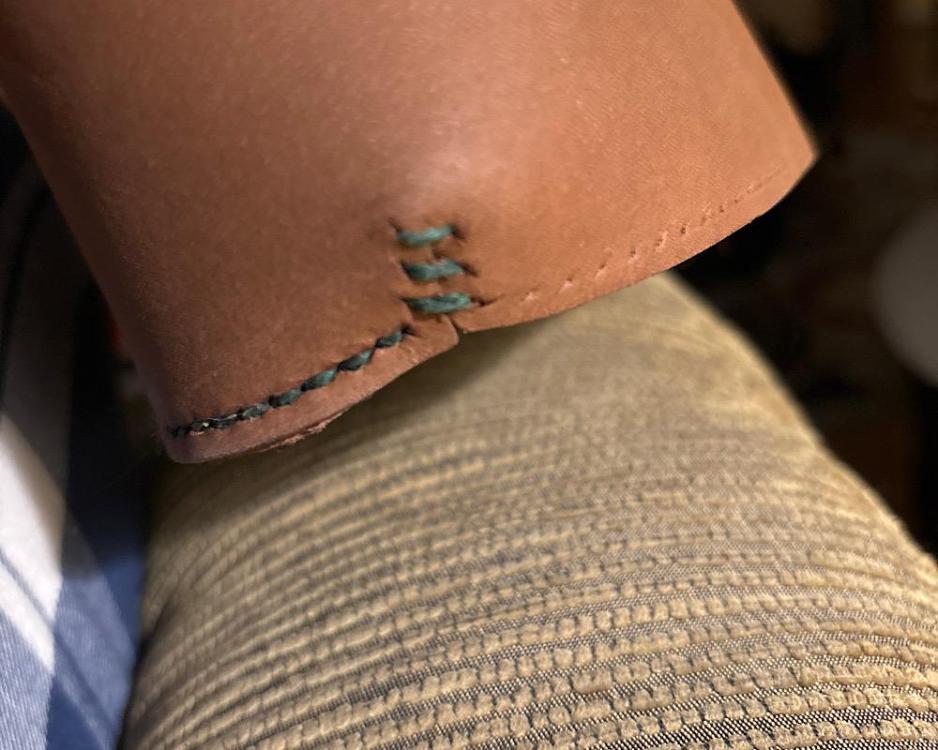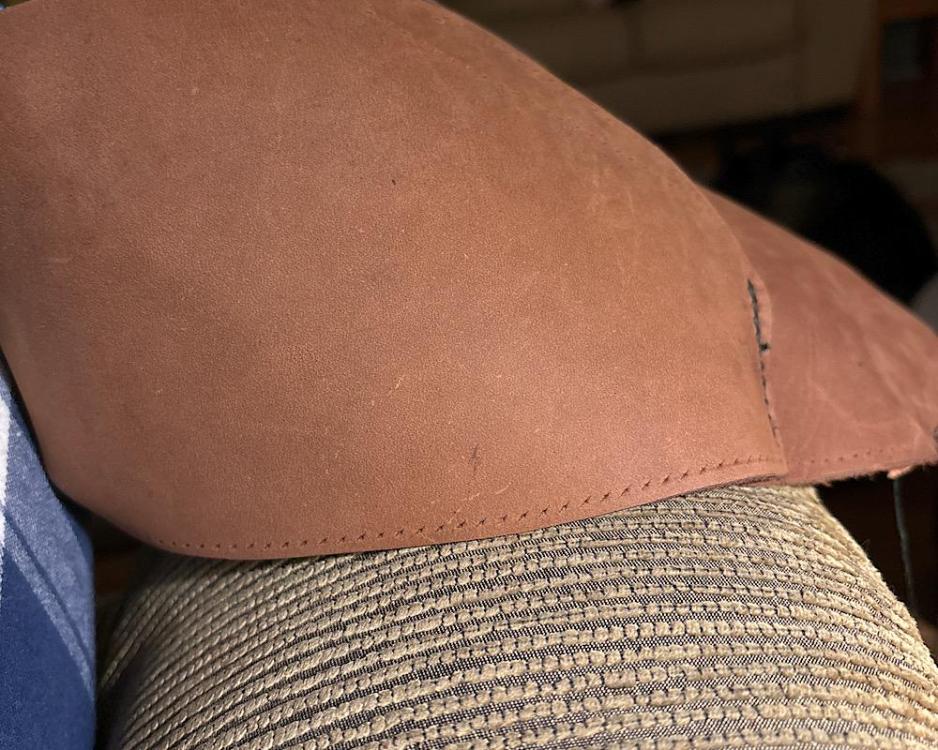
Mablung
Members-
Posts
570 -
Joined
-
Last visited
Content Type
Profiles
Forums
Events
Blogs
Gallery
Everything posted by Mablung
-
Different Holsters
Mablung replied to Dwight's topic in Gun Holsters, Rifle Slings and Knife Sheathes
Good work across the board. That Ruger is an ugly gun… -
Lovely work! I carry my phone in my back pocket and pull it out if I sit down. Don’t know if that’ll make any difference for you, now that you have a fantastic belt holster for it.
-
Oh, I see. Hmm. If I recall correctly, Resolene partially soaks in but also stays on the surface to an extent. You may be able to redye the worn spots, if the Resolene has been worn off sufficiently as well. I can't say I have tried that myself, though, so I really don't know for sure what would happen. Resolene is acrylic-based, not oil, so buffing the spot with rubbing alcohol may not work. I'll think on it, though I'm not experienced in these areas.
-
Don't blame you. That would be tough. I just resharpen my replaceable blades.
-
I think it borders on heresy to suggest one could have too many knives, so I'm glad to see you stick to orthodoxy. Gosh, now I want to get a cylinder of mapp gas and try my hand at some basic blacksmithing... A buddy of mine used to do some amateur blacksmithing on a small forge his dad built him and was going to teach me some basics one day. His coal and paper were a touch damp from rain a couple days before and bad Southern humidity, so we weren't able to, sadly.
-
There was a recent post (or maybe I just read it recently) about the Weaver burnisher machine and how people had modified it. I'll see if I can find the thread. In the meantime, if you dig through the archives or search Google for something like "site:leatherworker.net burnish machine," you'll find some good information already out there. Others may have some more up-to-date suggestions, too, though.
-
Neck Knife Sheath
Mablung replied to Stewart's topic in Gun Holsters, Rifle Slings and Knife Sheathes
"Me too" on wanting to see the blade. Also, how do you hang it around your neck? -
What are the blade dimensions? I'm not very good at judging things spatially and don't have a great sense of the scale from the closeup photos.
-
I picked up that idea from you and have found it most helpful indeed. I got an obnoxious cut on my finger from a dull awl that punched through the second layer of a piece rather violently, when I didn't use the cork. THAT taught me to use the cork religiously.
-
I like it. Mainly used for detail cutting in small-ish areas, trimming, or other purposes?
-
Re: applying and buffing, I also use a rag. I just have to let it dry for a minute first. I have read on here that sheepskin is the bee’s knees for antique, but I haven’t tried it personally. Did you have one of the wooden mallets? Definitely need something better. I would drop the coin on a rawhide mallet, if I were you. I spent a little less and got a Tandy Bakelite mallet—then I used a Tandy rawhide mallet in a carving class recently and wished I had bought one already.
-
Good suggestions from chuck123wapati. Hit a large stamp like that quite hard to get a good impression. Depending on how heavy your mallet/maul is, you'll need to give it some oomph, more than you'll think you do. I nearly never hit my stamps or punches hard enough the first time. The Tandy shoulders---which are mostly what I use, personally---can be hit or miss. The double shoulder I have currently has a far better grain and much smoother grain-side surface than the previous shoulder I purchased and used. That makes a pretty big difference. The sort of surface you use and minimizing bounce is more important when trying to prevent double impressions from the stamp bouncing. It doesn't look like you have that problem, so I wouldn't worry too much about that at this juncture. The biggest things, it seems, are ensuring you hit the stamp hard enough and making sure the leather has the right moisture content. I'm going to steal chuck's suggestion about wetting a scrap piece from the same portion so that I have something to use to check my moisture content on my main working piece.
-
+1 for the Stohlman case-making book. The sheath-making instructions are great. From there it’s easy to learn how to make welted fold-over sheaths, and then layered welted sheaths. Ton of fun, too, for something that can be as simple or as involved as you like. I started out making simple sheaths for one of my hunting knives. Great starter projects.
-
It’s not necessary, but I tend to soak my leather and stick it in a plastic bag to let the water work its way into the fibers thoroughly. Wetting it as much as I do requires leaving it out for a few hours to dry before trying to work with it, but it guarantees a consistent case. Play around with the amount of water you use, as long as you give it enough time to soak in evenly and consistently. That’s the most important thing. You might try getting a 9 oz craft panel to practice with. I find that additional thickness easier to work with. Also, any idea what part of the hide you’re using? Back, shoulder, belly? That will also affect how well it stamps and the method and degree to which it needs to be cased.
-
The moderator will tell you to post the pics here, because photos on third-party hosts have a tendency to vanish and because most people (I among them) don’t want to click on some random link to see a pic of something like this. As to the substantive issue, I’d think re-dyeing and finishing would help, but maybe you’re trying to blend the other weathered parts with the part that needs to be refinished.
-
It looks like the leather may have been too wet when you stamped it. Also, did you stamp the flesh (fuzzy) side? It looks that way. That can be done, but the definition is usually less clear. I may be misinterpreting the pictures, though. Did you allow the Resolene to dry fully? It doesn’t take long to dry, but it does need some time before it will act as a resist well. How did you apply it?
-
I skived the toe counter from a thicker piece, down to I think 2 oz or so. Part of the problem is that I cut it from a fairly firm 6/7 oz shoulder, so I made a boo-boo with the choice of leather. I’ve got a 2/3 shoulder that would likely work better because it’s a softer temper and pre-split. Calfskin would be preferable, though, and I can get it at my local Tandy. I wondered to myself if the counter would work better with a last, and I think you’re right that that’s where I lost my length. Thanks for the tip on the pattern sizing—I think that’s about the margin I had allowed, but I don’t recall off the top of my head. I think for the next pair, I’ll do a full mockup with craft foam to make sure my adjustments all work together properly. Otherwise, I’ll screw around with too many variables and not put them together properly. Thanks for the pointers! This is really helpful. I kinda want a pair of loafers as well, so I’ll do some moccasin-type shoes soon as well. That and I plan to use some old slippers to make a new lined pair because the soles have fallen apart. I’ll post those, too. I never thought I’d get into making even simple shoes, when I started doing leatherwork.
-
Well, a lot of things are right about these things, but the soles are a little too small (really not sure how I managed that, when I traced right from the completed shoe) and the veg tan toe counter in each is (a) too hard and (b) lacks sufficient toe volume. Wetting won’t do it, unfortunately. The leather is also thicker and firmer in temper than the previous stuff I used, so I need to adjust for that. Will need to adjust the pattern and then rebuild. Here’s a pic of one completed shoe. I think I’m going to either make a taller boot or lower the upper height just a bit as well; this height tended to cut into my ankle just a bit.
-
Hoping to get the soles glued tonight before I head out of town and can wear them in a bit. I'll get some pics, too.
-
Thanks! And yeah, I was thinking of doing the wet-walk-dry treatment to them. I think part of the reason the one felt tight is because I put a veg tan toe counter in the front, but I may need to add a little more "toe puff" to future iterations of the vamp and toe counter. We'll see how they come out after I move around in them a bit. I keep my toenails pretty short, so they shouldn't cause an issue.
-
These things have taken longer to complete than I anticipated. Got the eyelets set late last night, as well as stitching the midsole to the second upper. Now just need to cut and glue the rubber outsoles, stitch the eyelet reinforcement pieces on the second shoe, and run the laces. I think these will end up being just a little short of toe room, so I'll add that into the midsole pattern modification. I'll wear these for a bit to see if they stretch sufficiently and to figure out what other modifications I need to make, then go from there. Looking forward to finally having these done.
-
-
Couple other shots of one in progress. Haven’t stitched the midsole fully or the eyelet reinforcement pieces. The dart and mild curve in the top of the heel piece appear to be doing their job. We’ll know for sure once I finish stitching the midsole and glue on the rubber soles. I realized, in stitching the other one’s midsole the other night, that I erred by failing to adjust the width of the rear of the midsole heel for the material I removed from the upper heel piece. So, it’s a bit puckered at the back. In my test fit, though, it didn’t seem to make a difference and will become even less of an issue after I hammer it down a bit, hammer the stitches, and glue on the rubber.




